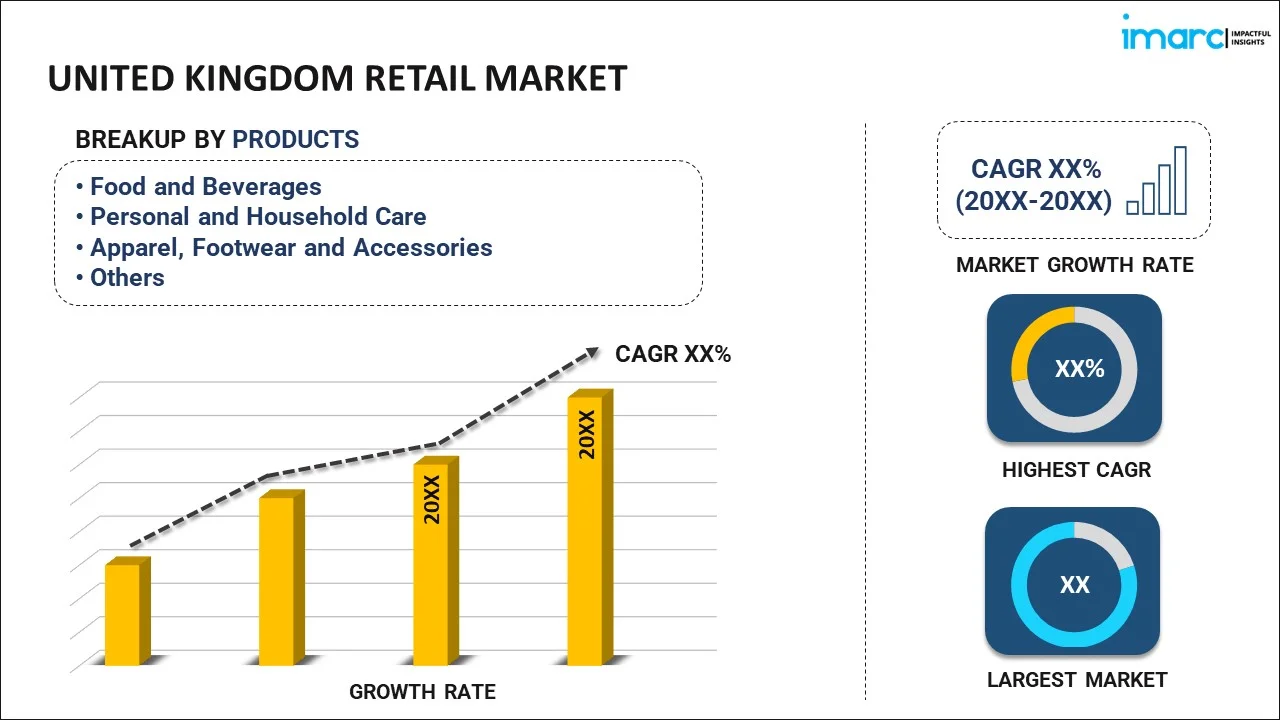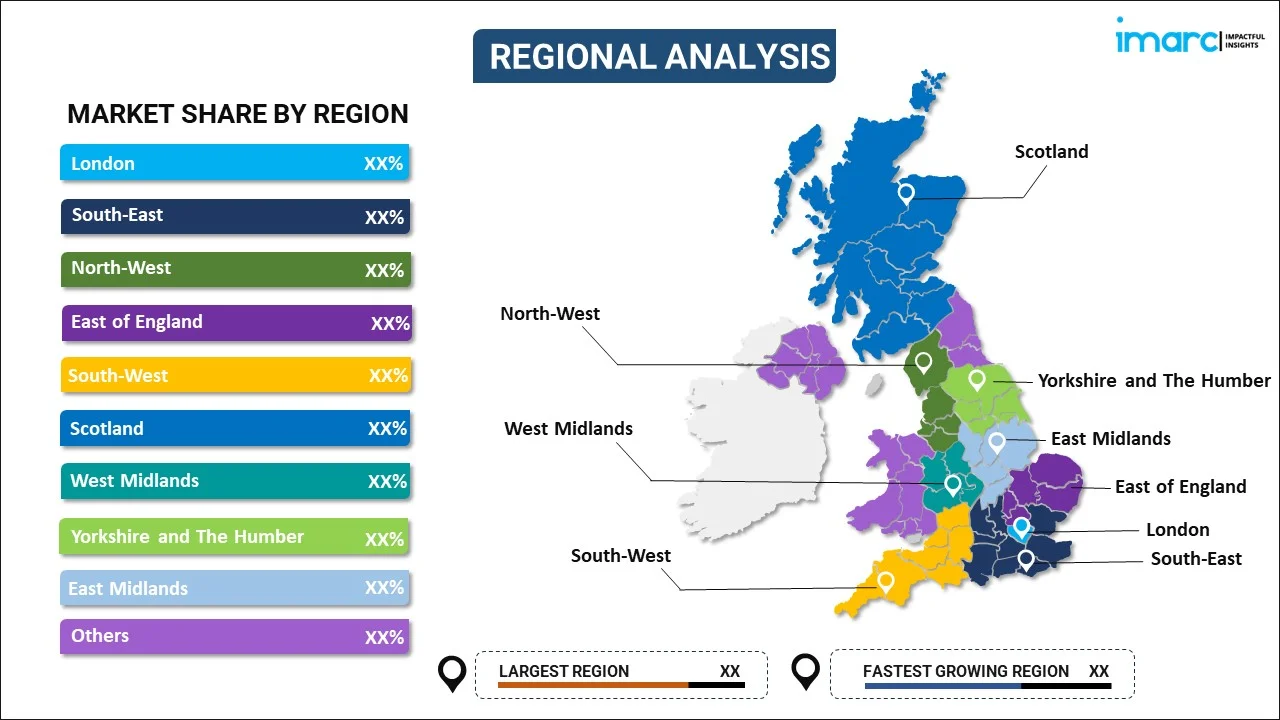
United Kingdom Retail Market Report by Product (Food and Beverages, Personal and Household Care, Apparel, Footwear and Accessories, Furniture, Toys and Hobby, Electronic and Household Appliances, and Others), Distribution Channel (Supermarkets and Hypermarkets, Convenience Stores, Specialty Stores, Online Stores, and Others), and Region 2024-2032
United Kingdom Retail Market Overview:
The United Kingdom retail market is projected to exhibit a growth rate (CAGR) of 4.40% during 2024-2032. The market is expanding due to the expansion of e-commerce platforms and digital transformation, rapid urbanization and population growth, increasing number of government policies and regulations, investments in retail infrastructure, and ongoing innovations in technology.
|
Report Attribute
|
Key Statistics
|
|---|---|
|
Base Year
|
2023 |
|
Forecast Years
|
2024-2032
|
|
Historical Years
|
2018-2023
|
| Market Growth Rate (2024-2032) | 4.40% |
United Kingdom Retail Market Trends:
Expansion of E-Commerce Platforms
E-commerce platforms are making shopping more accessible and convenient for people. They can peruse and make purchases at their convenience and from the comfort of their homes, offices or any place that is connected to the internet. Moreover, e-commerce allows retailers to offer a much wider range of products compared to traditional brick-and-mortar stores. This expanded product selection caters to diverse consumer preferences and increases the likelihood of finding specific or niche items. Operating an e-commerce platform often incurs lower overhead costs compared to maintaining physical stores. This cost efficiency can lead to cheaper prices for buyers and increased profit margins for retailers.
In line with this, e-commerce platforms use data analytics and artificial intelligence to tailor the shopping experience. They can be used to make recommendations based on individual behavior and choices, thus increasing satisfaction and sales. An article published in 2023 on the website of the International Trade Administration (ITA) shows that the e-commerce revenues in the UK are expected to have an annual average growth rate of 12.6% by 2025.
Rapid Urbanization
According to the content updated on the website of the Central Intelligence Agency (CIA), the urban population in UK was 84.6% of total population in 2023. Urbanization leads to higher population density in cities and metropolitan areas. This attention of people creates a bigger capacity customer base for outlets, as there are more people near to retail establishments. Furthermore, urban residents often prioritize convenience in their shopping habits due to busy lifestyles and limited time. Retailers respond by offering easily accessible stores, online shopping options, and services like click-and-collect same-day delivery, meeting the demand for convenience-driven shopping experiences. In addition, urbanization involves growth of structural frameworks for retailing which includes shopping centers, malls, and high street stores. These shopping centres attract residents as well as tourists, increasing the activity and dynamism of the retail environment.
Besides this, urban areas often set trends in fashion, lifestyle, and consumer behavior. Retailers located in urban centers can capitalize on this by staying ahead of trends, offering innovative products, and creating unique shopping experiences that appeal to trend-conscious buyers.
United Kingdom Retail Market News:
- June 19, 2024: UK-based premium womenswear brand Raishma entered the Indian market with its vibrant summer collection, Full Bloom. This brand is also available on popular multi-brand e-commerce platforms Nykaa Fashion, Ajio, and Aza.
- June 18, 2024: Aldi UK, a supermarket chain planned to invest more than £90 million in store improvements throughout 2024, including the refurbishment of more than 30 stores this summer.
United Kingdom Retail Market Segmentation:
IMARC Group provides an analysis of the key trends in each segment of the market, along with forecasts at the country level for 2024-2032. Our report has categorized the market based on product and distribution channel.
Product Insights:

- Food and Beverages
- Personal and Household Care
- Apparel, Footwear and Accessories
- Furniture, Toys and Hobby
- Electronic and Household Appliances
- Others
The report has provided a detailed breakup and analysis of the market based on the product. This includes food and beverages, personal and household care, apparel, footwear and accessories, furniture, toys and hobby, electronic and household appliances, and others.
Distribution Channel Insights:
- Supermarkets and Hypermarkets
- Convenience Stores
- Specialty Stores
- Online Stores
- Others
A detailed breakup and analysis of the market based on the distribution channel have also been provided in the report. This includes supermarkets and hypermarkets, convenience stores, specialty stores, online stores, and others.
Regional Insights:

- London
- South East
- North West
- East of England
- South West
- Scotland
- West Midlands
- Yorkshire and The Humber
- East Midlands
- Others
The report has also provided a comprehensive analysis of all the major regional markets, which include London, South East, North West, East of England, South West, Scotland, West Midlands, Yorkshire and The Humber, East Midlands, and Others.
Competitive Landscape:
The market research report has also provided a comprehensive analysis of the competitive landscape. Competitive analysis such as market structure, key player positioning, top winning strategies, competitive dashboard, and company evaluation quadrant has been covered in the report. Also, detailed profiles of all major companies have been provided.
United Kingdom Retail Market Report Coverage:
| Report Features | Details |
|---|---|
| Base Year of the Analysis | 2023 |
| Historical Period | 2018-2023 |
| Forecast Period | 2024-2032 |
| Units | Billion US$ |
| Scope of the Report | Exploration of Historical Trends and Market Outlook, Industry Catalysts and Challenges, Segment-Wise Historical and Future Market Assessment:
|
| Products Covered | Food and Beverages, Personal and Household Care, Apparel, Footwear and Accessories, Furniture, Toys and Hobby, Electronic and Household Appliances, Others |
| Distribution Channels Covered | Supermarkets and Hypermarkets, Convenience Stores, Specialty Stores, Online Stores, Others |
| Regions Covered | London, South East, North West, East of England, South West, Scotland, West Midlands, Yorkshire and The Humber, East Midlands, Others |
| Customization Scope | 10% Free Customization |
| Post-Sale Analyst Support | 10-12 Weeks |
| Delivery Format | PDF and Excel through Email (We can also provide the editable version of the report in PPT/Word format on special request) |
Key Questions Answered in This Report:
- How has the United Kingdom retail market performed so far and how will it perform in the coming years?
- What has been the impact of COVID-19 on the United Kingdom retail market?
- What is the breakup of the United Kingdom retail market on the basis of product?
- What is the breakup of the United Kingdom retail market on the basis of distribution channel?
- What are the various stages in the value chain of the United Kingdom retail market?
- What are the key driving factors and challenges in the United Kingdom retail?
- What is the structure of the United Kingdom retail market and who are the key players?
- What is the degree of competition in the United Kingdom retail market?
Key Benefits for Stakeholders:
- IMARC’s industry report offers a comprehensive quantitative analysis of various market segments, historical and current market trends, market forecasts, and dynamics of the United Kingdom retail market from 2018-2032.
- The research report provides the latest information on the market drivers, challenges, and opportunities in the United Kingdom retail market.
- Porter's five forces analysis assist stakeholders in assessing the impact of new entrants, competitive rivalry, supplier power, buyer power, and the threat of substitution. It helps stakeholders to analyze the level of competition within the United Kingdom retail industry and its attractiveness.
- Competitive landscape allows stakeholders to understand their competitive environment and provides an insight into the current positions of key players in the market.
Need more help?
- Speak to our experienced analysts for insights on the current market scenarios.
- Include additional segments and countries to customize the report as per your requirement.
- Gain an unparalleled competitive advantage in your domain by understanding how to utilize the report and positively impacting your operations and revenue.
- For further assistance, please connect with our analysts.
 Inquire Before Buying
Inquire Before Buying
 Speak to an Analyst
Speak to an Analyst
 Request Brochure
Request Brochure
 Request Customization
Request Customization




.webp)




.webp)












